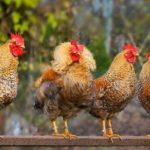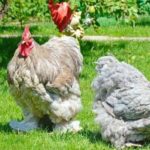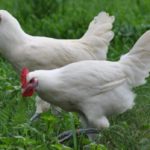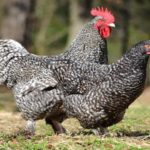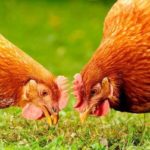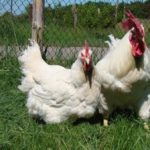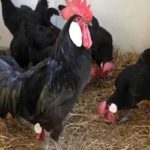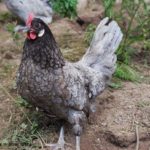Oryol ornamental chickens are a breed bred in Russia and undeservedly forgotten. These are meat-egg birds, with very interesting feather coloring and constitution. Domestic chickens are similar to birds of prey. Roosters have a cocky and warlike character. The thing is that fighting chickens were used to breed the Oryol breed. Laying hens have a calmer disposition, and they lay eggs well.
- Breeding history
- Description and characteristics of Orlovskaya calico chickens
- What do birds look like?
- Productive qualities of the breed
- Character of chickens
- Main advantages and disadvantages
- Content Features
- Arranging a chicken coop and walking yard
- Preparing feeders and drinkers
- Shedding
- Planned replacement of livestock
- Bird food
- Chickens
- Adults
- What you need to know about breeding
- Common diseases
- How to choose a purebred bird?
- Analogs
Breeding history
Oryol chickens are an old Russian breed. This is an egg-meat variety of chickens with mottled plumage. Laying hens have extraordinary coloring and a calm disposition, but they lay poorly - they produce only 145-185 eggs per year. But roosters look menacing thanks to the feathers raised on their necks. And their character is cocky and aggressive.
Chickens were developed in Russia in the 19th century. At first, they were grown on Russian peasant farms. Prince Alexey Orlov-Chesmensky was actively involved in the selection of this breed. Oryol chickens are descended from Malayan fighting chickens and Persian chickens. The following varieties took part in the formation of this breed: Bruges Fighting, Russian Ushanka, Tyurin.
Oryol chickens were very popular in the USA in the 19th century, and Europe learned about them a little later - at the beginning of the 20th century. However, by the middle of the last century, this breed was replaced by more productive varieties of chickens. In 1925, dwarf, decorative Oryol chickens were bred in Western Europe. In Russia, the once famous breed was revived only in the 80s of the last century.
Description and characteristics of Orlovskaya calico chickens
Oryol roosters became famous for their unusual appearance, cockiness and upright body. Their plumage is thick and, as a rule, variegated and multi-colored. These chickens are considered ornamental birds. They are bred mainly by fans of show breeds.
What do birds look like?
Oryol chickens have a powerful body, long neck, and lush plumage. The bird's height is about 60 centimeters. Roosters have a slender, fighting figure, the neck has a fighting bend. They stick their chest forward. The body is located almost vertically. The head is small and flat.The beak is yellowish, short, curved. Eyes with overhanging brow ridges, coloring - reddish-amber.
The legs are strong, tall, muscular, yellowish in color, without feathers. The feathers on the nape are raised. In front, the feathers form a semblance of sideburns and a beard. The tail is long and bushy. The comb is small, crimson in color, with small bristles. The earlobes and earrings are poorly developed. Laying hens are more squat, but in other respects they are similar to roosters. The plumage of birds can be bright red, walnut, calico (red-black-white), yellowish, white, mahogany, and black.
Productive qualities of the breed
Oryol chickens belong to the meat and egg breed. Adult roosters weigh 3-4.5 kilograms. The weight of laying hens is 2.5-3 kilograms. In a year, a chicken can lay almost 180 eggs. With age, the egg production of laying hens decreases to 120, 100 eggs. The weight of one egg is 60 grams. The shell is cream or pale pink in color. Laying hens begin laying eggs at seven months of age. Maximum weight is gained in 2 years. The meat is tough and tastes vaguely like game.
Character of chickens
The Oryol breed adapts well to any climate, tolerating severe frosts and cool, rainy weather. True, the chicks fledge slowly and require special care in the first weeks of life.
Laying hens have a calm character. They have a poorly developed egg incubation instinct. Previously, before the advent of hybrids, this feature of the breed resulted in greater egg production compared to other domestic chickens. Roosters are strong, cocky, aggressive. It is better not to house them with other poultry.
Main advantages and disadvantages
Positive qualities of the breed:
- decorative plumage;
- extraordinary appearance;
- excellent survival rate;
- Possibility of breeding for eggs and meat.
Disadvantages of the Oryol breed:
- low egg production;
- long growing period;
- Chickens need special care.
Content Features
Oryol chickens have good immunity, but the birds need to be provided with proper care and quality nutrition. Chicks require special attention in the first weeks of life.
Arranging a chicken coop and walking yard
The chicken coop should have perches and baskets or boxes for laying eggs. The room should be bright and spacious. Laying hens do not lay eggs in the dark. For 15 birds, the optimal size of the chicken coop is 10 square meters.
In winter, it is recommended to insulate the room where the chickens are located using heaters. You can sprinkle straw or sawdust on the floor. Birds can freeze at an air temperature of 10 degrees below zero. The optimal temperature for keeping the Oryol breed in a chicken coop is 18-22 degrees Celsius.
At a temperature of 10 degrees above zero, the egg production of birds decreases.
It is advisable to arrange a walking yard for chickens. Feeders and drinking bowls must be placed in the area intended for walking. You can give the birds the opportunity to walk throughout the entire territory of the garden plot. It is recommended to keep the Oryol breed separately from other birds. If it is not possible to organize a walking yard, you can raise chickens in cages.
Preparing feeders and drinkers
For Oryol chickens, you need to build special feeders and drinkers that are suitable for their short beak. Long grooved boxes or hopper plastic feeders are used as feeding containers. In order to water the birds, use any shallow plate or commercial siphon drinker.
Shedding
Once a year, chickens shed heavily. Molting occurs from October to December. Lasts 30-40 days.During molting, chickens stop laying eggs, they lose their appetite, which is why they often lose weight and often get sick.
Planned replacement of livestock
Oryol chickens are an expensive breed. Birds are rarely raised for their eggs or meat. More often - as a decorative breed. If chickens are bred for consumer purposes, then you need to remember that egg production decreases with age. Every 3-4 years the herd is renewed.
Bird food
Particular attention should be paid to the diet. Bird nutrition has its own characteristics, depending on age. Adults are fed 2-3 times a day. They eat 20-30 grams of grain at a time. Young animals are fed more often - every 2-3 hours. Birds wake up at 5 am and go to bed at 9 pm. The chickens are not fed at night.
Chickens
Young chicks are fed in the first hours after hatching. First, the chicks are given millet, corn grits, boiled yolk, and cottage cheese. Chickens are fed 6-7 times a day. Later, the diet is enriched with special feed, herbs, and carrots. Fresh water is poured into the drinking bowls every time. It is useful to give chickens store-bought vitamins and minerals and medications to prevent diseases.
Adults
Adult chickens are not fed whole grains. Birds are fed crushed cereals (barley, wheat, corn, oatmeal, buckwheat) or mixed feed. Dry food can be alternated with wet mash made from boiled potatoes and steamed cereals. It is useful to give birds cottage cheese, chalk, and salt. The coop should have sand or fine gravel. The menu of adults can be diversified with herbs (nettle, alfalfa) and vegetables (carrots, cabbage, fodder beets).
What you need to know about breeding
Adult Oryol chickens are kept like ordinary domestic laying hens and roosters. Laying hens have a poorly developed instinct to hatch eggs.Chickens are produced using an incubator. Hatched chicks need special care.
Chicks develop slowly and fledge late. They often suffer from weak legs and crookedness. In the first weeks of life, chickens are kept in a room with an air temperature of 30 degrees Celsius. The chicken coop should be spacious so that the chicks can run around. For proper development, chickens need to move a lot. Young animals can be released into fresh air at 2 months of life if the street temperature is 23-25 degrees Celsius. Sunlight promotes better development of young animals and replenishes vitamin D deficiency.
Common diseases
The Oryol breed has good immunity. However, if not properly cared for, birds can get sick. Common diseases: vitamin deficiency, tenosynovitis, gout, abdominal dropsy, cloacitis, gastroenteritis. Sick birds lose their appetite, diarrhea begins, they move little, and stop laying eggs.
For prevention, young animals are given vitamins and minerals; during periods of illness, the veterinarian prescribes medications. Birds can suffer from mites and lice. Ticks settle on the legs - under the scales. Creolin solution saves you from them. Tsiodrin and Entobacterin help against lice.
How to choose a purebred bird?
When choosing pure Oryol breed chickens, you need to pay attention to the following nuances:
- growth and body structure must correspond to breed standards;
- the presence of a developed scruff, beard and sideburns;
- long, yellowish legs without feathers;
- the beak is small, curved, like that of an eagle;
- a small comb resembling a raspberry;
- underdeveloped earlobes and earrings;
- a small flat head with powerful brow ridges, similar to the head of a bird of prey;
- feather coloring corresponding to the breed.
Unacceptable defects of the breed: short stature, too little weight, horizontal body (for roosters), hunchbacked back. In purebred individuals, the beak should not be straight.
Analogs
Oryol chickens are a unique breed of birds. It is quite difficult to find analogues for them. Orlovskys are often compared to the Malayan fighting breed. True, the birds are not very similar in appearance, but they have a similar character.











